The main purpose of a SQL CASE expression returns a value based on one or more conditional tests. Use CASE expressions anywhere in a SQL statement expression is allowed. Though truly an expression, some people refer to them as “CASE statements.” This most likely stems from their use in programming languages.
The SQL CASE expression is extremely versatile and used throughout SQLServer queries. In particular it is used in the SELECT column list, GROUP BY, HAVING, and ORDER BY clauses. The CASE expression also standardizes (beautify) data or performs checks to protect against errors, such as divide by zero.
All the examples for this lesson are based on Microsoft SQL Server Management Studio and the AdventureWorks2012 database. Getting Started Using SQL Server using my free guide and free Microsoft tools.
Table of contents
SQL Server CASE Statement Forms
There are two forms for the CASE clause: simple and searched. Both forms return a result based on testing an expression. Though technically expressions, you’ll see many people refer to it as a statement.
The simple SQL CASE statement is used for equality tests. It tests one expression against multiple values, this makes it great for transforming one set of values, such as abbreviations to their corresponding long form.
The searched SQL CASE statement uses a more comprehensive expression evaluation format. It is good when you wish to work with ranges of data, such as salary ranges or ages.
We first start out with the simple form, and then cover searched.
CASE expression Simple Form
The simple form of the CASE expression compares the results of an expression with a series of tests and return a “result” when the “test” returns true.
The general form for a simple form CASE expression is:
CASE expression
WHEN test THEN result
…
ELSE otherResult
END
The ELSE statement is optional in a CASE expression. It returns “otherResult” when no matches are made and ELSE is present. If there is no ELSE in the CASE statement, then it returns NULL.
The ELSE clause is a great way to catch bad or unexpected data values, and return a result other than NULL.
Here are some things to consider when using the simple CASE expression:
- Allows only equality comparisons.
- Evaluates tests are evaluated in the order defined.
- Returns the result corresponding to the first TRUE test.
- If no match is made, case returns NULL unless ELSE is present.
CASE expression Searched Form
The search form of the CASE expression allows for more versatile testing. Use it to evaluate a greater range of tests. In fact, any Boolean expression qualifies as a test.
A searched from CASE expression has this format
CASE
WHEN booleanExpression THEN result
…
ELSE otherResult
END
With the searched form, use WHEN clauses to evaluate Boolean expressions. The result of the first TRUE Boolean expression is returned.
Below is the searched CASE form of the employee gender example from the previous section.
SELECT JobTitle,
CASE
WHEN Gender = 'M' THEN 'Male'
WHEN Gender = 'F' THEN 'Female'
ELSE 'Unknown Value'
END
FROM HumanResources.Employee
We also used this same example for the simple SQL case statement. I did this so you could see the subtle difference. Notice that each WHEN clause now contains the test as a Boolean expression.
Comparison of Simple and Searched Forms SQL CASE
Here are the statements side-by-side:
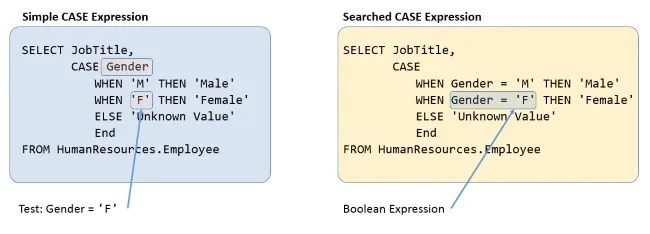
 Simple versus Searched CASE expression
Simple versus Searched CASE expressionI tend to use the searched CASE expression format in all my SQL. This reason is simple, I only have to remember one format!
Since we’re testing Boolean expressions, the searched CASE statement isn’t limited to just equality tests.
Use CASE to Compare a Range of Values
This makes this form really good for comparing ranges of values. Perhaps the sales manager of Adventure Works wants to organize products by price range. How could this be done with SQL?
Given the following names and ranges provided by the sales manager, we can construct a CASE expression to compare the ListPrice to a range of values and then return the appropriate price range name.
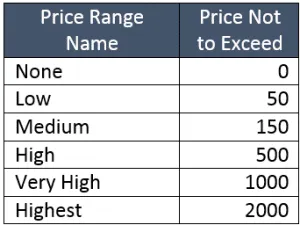
The case statement is placed in the SELECT column list and returns a character value. Here’s the SQL that does the trick:
SELECT Name,
ListPrice,
CASE
WHEN ListPrice = 0 THEN 'No Price'
WHEN ListPrice > 0 AND ListPrice <= 50 THEN 'Low'
WHEN ListPrice > 50 AND ListPrice <= 150 THEN 'Medium'
WHEN ListPrice > 150 AND ListPrice <= 500 THEN 'High'
WHEN ListPrice > 500 AND ListPrice <= 1000 THEN 'Very High'
WHEN ListPrice > 1000 AND ListPrice <= 2000 THEN 'Highest'
WHEN ListPrice > 2000 THEN 'Luxury'
ELSE 'UNLISTED'
END as PriceRange
FROM Production.Product
When you run this query you’ll see PriceRange listed and displaying values according to the ranges specified in the CASE expression:
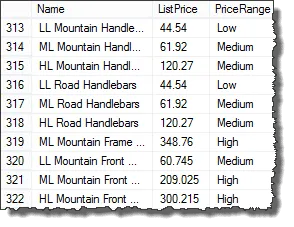
Data Transformation Example
There are several reasons to use a CASE statement. The first is to transform data from one set of values to another. For instance, to display an employee’s gender as “Male” or “Female,” when your data is encoded as “M” or “F,” use a CASE expression to test for the single character representation and return its corresponding long form.
The example for this is:
SELECT JobTitle,
CASE Gender
WHEN 'M' THEN 'Male'
WHEN 'F' THEN 'Female'
ELSE 'Unknown Value'
END
FROM HumanResources.Employee
Data Standardization Example
Similarly you can use a simple CASE clause to standardize several values into one. Extending our example maps several variations to either Male or Female:
SELECT JobTitle,
CASE Gender
WHEN 'M' THEN 'Male'
WHEN '0' THEN 'Male'
WHEN 'F' THEN 'Female'
WHEN '1' THEN 'Female'
ELSE 'Unknown Value'
END
FROM HumanResources.Employee
You may be wondering if you could just create another table in your database and use that to lookup the values. I would tend to agree that would be the best, but in many situations you won’t have permission to create tables in the database. In this case you’re left to your wits a SELECT statement’s provides.
SQL CASE Prevents SQL Errors!
CASE statements can also be used to help prevent errors. A good example is to test for valid values within expressions such as when you divide numbers.
Consider
SELECT ProductID,
Name,
ProductNumber,
StandardCost,
ListPrice,
StandardCost / ListPrice as CostOfGoodSold
FROM Production.Product
This statement return the message
Divide by zero error encountered.
By using a CASE clause we can ensure we don’t inadvertently divide by zero.
SELECT ProductID,
Name,
ProductNumber,
StandardCost,
ListPrice,
CASE
WHEN ListPrice = 0 Then NULL
ELSE StandardCost / ListPrice
END as CostOfGoodSold
FROM Production.Product
A CASE expression can be used wherever an expression can be used. This means you can use it to return a column value result or even use it in an ORDER BY clause.
CASE in SELECT
In the following section we’ll explore using CASE in the ORDER BY and GROUP BY clauses.
CASE expression in ORDER BY
Continuing on with the sales manager request, suppose she also wants to see the products sorted by price range and then product name. We’ve seen how we can display the price ranges as a column, but how do we sort?
Actually it is pretty easy. Since CASE is an expression, we can use it as once of the values from which order the results. Remember, we aren’t limited to just sorting table columns, we can also sort an expression.
Here is the query to sort by the price range.
SELECT Name,
ListPrice
FROM Production.Product
ORDER BY CASE
WHEN ListPrice = 0 THEN 'No Price'
WHEN ListPrice > 0 AND ListPrice <= 50 THEN 'Low'
WHEN ListPrice > 50 AND ListPrice <= 150 THEN 'Medium'
WHEN ListPrice > 150 AND ListPrice <= 500 THEN 'High'
WHEN ListPrice > 500 AND ListPrice <= 1000 THEN 'Very High'
WHEN ListPrice > 1000 AND ListPrice <= 2000 THEN 'Highest'
WHEN ListPrice > 2000 THEN 'Luxury'
ELSE 'UNLISTED'
END,
Name
We can then add CASE statement to SELECT list to also display the price range.
SELECT Name,
ListPrice,
CASE
WHEN ListPrice = 0 THEN 'No Price'
WHEN ListPrice > 0 AND ListPrice <= 50 THEN 'Low'
WHEN ListPrice > 50 AND ListPrice <= 150 THEN 'Medium'
WHEN ListPrice > 150 AND ListPrice <= 500 THEN 'High'
WHEN ListPrice > 500 AND ListPrice <= 1000 THEN 'Very High'
WHEN ListPrice > 1000 AND ListPrice <= 2000 THEN 'Highest'
WHEN ListPrice > 2000 THEN 'Luxury'
ELSE 'UNLISTED'
END as PriceRange
FROM Production.Product
ORDER BY CASE
WHEN ListPrice = 0 THEN 'No Price'
WHEN ListPrice > 0 AND ListPrice <= 50 THEN 'Low'
WHEN ListPrice > 50 AND ListPrice <= 150 THEN 'Medium'
WHEN ListPrice > 150 AND ListPrice <= 500 THEN 'High'
WHEN ListPrice > 500 AND ListPrice <= 1000 THEN 'Very High'
WHEN ListPrice > 1000 AND ListPrice <= 2000 THEN 'Highest'
WHEN ListPrice > 2000 THEN 'Luxury'
ELSE 'UNLISTED'
END,
Name
As you can see, things start to get complicated. Do you see how the CASE statement is repeated in both the SELECT list and ORDER BY? Fortunately, we can simplify this a bit, but removing the CASE statement from the ORDER BY and replacing it with the SELECT list CASE expression’s alias name PriceRange as so:
SELECT Name,
ListPrice,
CASE
WHEN ListPrice = 0 THEN 'No Price'
WHEN ListPrice > 0 AND ListPrice <= 50 THEN 'Low'
WHEN ListPrice > 50 AND ListPrice <= 150 THEN 'Medium'
WHEN ListPrice > 150 AND ListPrice <= 500 THEN 'High'
WHEN ListPrice > 500 AND ListPrice <= 1000 THEN 'Very High'
WHEN ListPrice > 1000 AND ListPrice <= 2000 THEN 'Highest'
WHEN ListPrice > 2000 THEN 'Luxury'
ELSE 'UNLISTED'
END as PriceRange
FROM Production.Product
ORDER BY PriceRange, Name
CASE expression in GROUP BY
Now that we’ve given the sales manager a detailed listing she wants to see summary data – doesn’t it ever end? In my experience it doesn’t, so knowing lots of SQL to satiate customer demands is your key to success.
Anyways, the good news is we can use the CASE expression we’ve built to create summary groups. In the following SQL we’re grouping the data by PriceRange. Summary statistics on the minimum, maximum, and average ListPrice are created.
SELECT
CASE
WHEN ListPrice = 0 THEN 'No Price'
WHEN ListPrice > 0 AND ListPrice <= 50 THEN 'Low'
WHEN ListPrice > 50 AND ListPrice <= 150 THEN 'Medium'
WHEN ListPrice > 150 AND ListPrice <= 500 THEN 'High'
WHEN ListPrice > 500 AND ListPrice <= 1000 THEN 'Very High'
WHEN ListPrice > 1000 AND ListPrice <= 2000 THEN 'Highest'
WHEN ListPrice > 2000 THEN 'Luxury'
ELSE 'UNLISTED'
END as PriceRange,
Min(ListPrice) as MinPrice,
Max(ListPrice) as MaxPrice,
AVG(ListPrice) as AvgPrice,
Count(ListPrice) as NumberOfProducts
FROM Production.Product
GROUP BY CASE
WHEN ListPrice = 0 THEN 'No Price'
WHEN ListPrice > 0 AND ListPrice <= 50 THEN 'Low'
WHEN ListPrice > 50 AND ListPrice <= 150 THEN 'Medium'
WHEN ListPrice > 150 AND ListPrice <= 500 THEN 'High'
WHEN ListPrice > 500 AND ListPrice <= 1000 THEN 'Very High'
WHEN ListPrice > 1000 AND ListPrice <= 2000 THEN 'Highest'
WHEN ListPrice > 2000 THEN 'Luxury'
ELSE 'UNLISTED'
END
ORDER BY MinPrice
Unlike the ORDER BY clause, we can’t reference the column alias PriceRange in the GROUP BY. The entire CASE expression has to be repeated. Here are the results of our query:
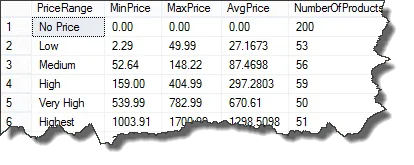
CASE in WHERE Clause
You can also use a CASE in the WHERE clause. This is particularly handy if want one of several values to evaluate to a condition.
Continuing with the Gender example, we can write the following CASE in a WHERE clause to test for female employees:
SELECT JobTitle, Gender
FROM HumanResources.Employee
WHERE CASE Gender
WHEN 'M' THEN 'Male'
WHEN '0' THEN 'Male'
WHEN 'F' THEN 'Female'
WHEN '1' THEN 'Female'
ELSE 'Unknown Value'
END = 'Female'
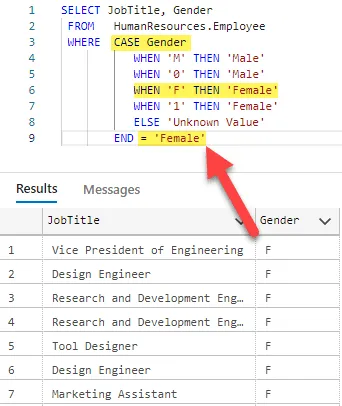
You could have also solved this problem using BOOLEAN logic, or a IN clause, but as the logic get more complex, you may find it is easier to express it with a CASE, rather than those other techniques. It can make your code easier to read and maintain.
CASE with CTE
Speaking of readability and maintainability, why not just wrap the CASE expression within a Common Table Express (CTE) to avoid “sprinkling” the CASE logic through out your code?
Here we use a CTE to define the CASE result once, then reuse that result in the outer query:
;WITH cteEmployee as
(
SELECT JobTitle, Gender,
CASE Gender
WHEN 'M' THEN 'Male'
WHEN '0' THEN 'Male'
WHEN 'F' THEN 'Female'
WHEN '1' THEN 'Female'
ELSE 'Unknown Value'
END GenderResult
FROM HumanResources.Employee
)
SELECT JobTitle, Gender, GenderResult
FROM cteEmployee
WHERE GenderResult = 'Female'
ORDER BY GenderResult
To make it more clear, check out the following which shows how this is done with a CASE statement. Notice the cteEmployee is used to calculate the GenderResult, which is then reused in the SELECT, WHERE, and ORDER BY clauses!
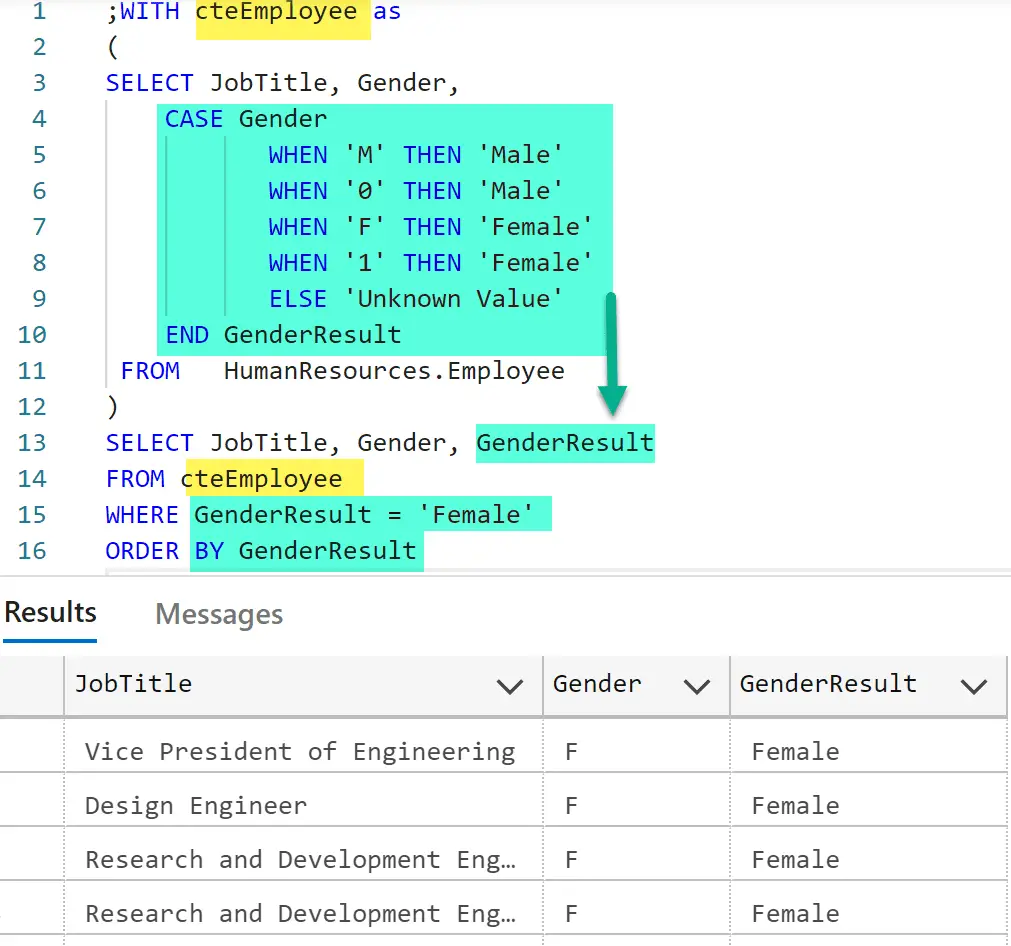
To learn more about Common Table Expressions, check out Common Table Expressions – The Ultimate Guide.
Wrap Up
As you can see, using CASE expressions adds versatility to your SQL statements. They not only allow you to transform data from one set of values to another, but can also be used to ensure statements don’t return errors.
Out of the two forms, simple and searched, I tend use the search form. The reason is that the simple form is limited to equality tests; whereas, the searched form can do that and more.
Since CASE expressions are expressions and not statements or clauses, they can be used where any other expression is used. That mean you can use throughout the SELECT statement and elsewhere in SQL.





Leave a Reply